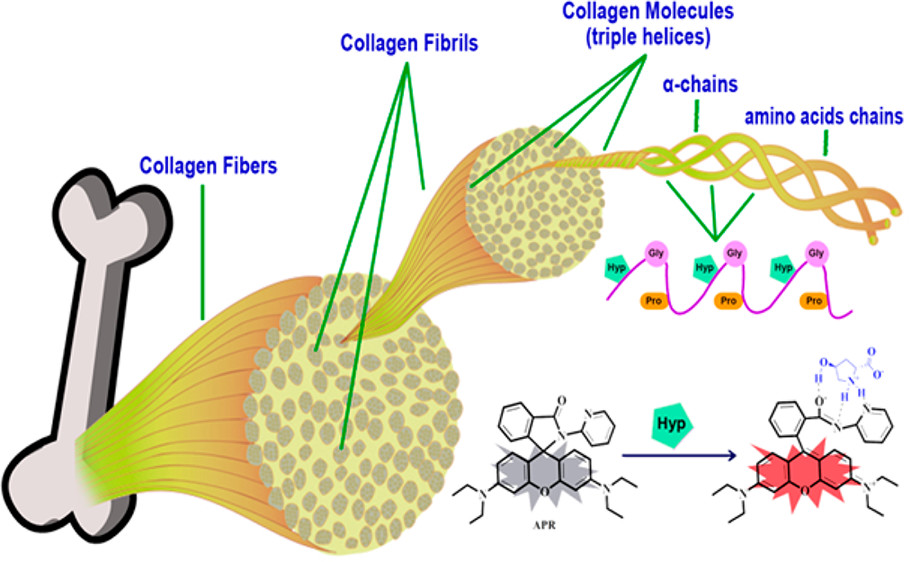v-innovate Technologies can provide high performance liquid chromatography (HPLC) method combined with UV detector to detect L-4-Hydroxyproline, which can provide comprehensive and scientifically accurate analysis report for the identification and analysis of L-4-Hydroxyproline in collagen. This detection method has the advantages of high sensitivity and simplified operation process, which can quickly obtain detailed amino acid analysis results to help customers further explore the application of L-4-Hydroxyproline and related L-4-Hydroxyproline metabolite research.
L-4-Hydroxyproline is a non-essential amino acid mainly present in human protein collagen, and its content in mammalian collagen is as high as 13.5%. Hydroxyproline is used as the main component of structural proteins (such as collagen, connective tissue, plant cell walls, tendons and ligaments) and provides skin elasticity. At the same time, it is often used as a food flavor enhancer and the field of nutritional supplements. This amino acid has a special feature that it is not incorporated into collagen during the biosynthesis at the ribosome level, but is formed by post-translational modification of proline through enzymatic hydroxylation. Taking advantage of the feature that hydroxyproline has the highest content in collagen, the catabolism of collagen in the body can be understood through the determination of hydroxyproline. However, there are still many challenges in the determination of hydroxyproline. Fortunately, high performance liquid chromatography combined with UV detector detection can realize the accurate determination of L-4-hydroxyproline, using phenyl isothiocyanate (PITC) as the pre-column derivatizing agent, and using external standard method to determine L-4 -Hydroxyproline is tested, and the chromatographic-based method has a high throughput, which can meet the needs of high-throughput analysis.
 Figure 1. Amino pyridine-based rhodamine conjugate (APR) has been developed as a first chemosensor for selective detection and quantification of L-4-Hydroxyproline (Hyp). (Sarkar 2017).
Figure 1. Amino pyridine-based rhodamine conjugate (APR) has been developed as a first chemosensor for selective detection and quantification of L-4-Hydroxyproline (Hyp). (Sarkar 2017).
This experiment uses HPLC combined with ultraviolet detectors, uses a special amino acid analysis column, uses phenyl isothiocyanate (PITC) as the pre-column derivatization agent, and uses an external standard method to analyze the L-4-Hydroxyproline Amino acid is tested. The operation process of this experiment is simplified, which can meet the needs of high-throughput sample analysis.
 Figure 2. L-4-Hydroxyproline analysis service workflow.
Figure 2. L-4-Hydroxyproline analysis service workflow.
Quantitation method: standard curve method, external standard method
Flow rate: 1.0ml/min
Wavelength: 254nm
Detection limit: 1.5mg/kg
Linear range: 0.125-6.25mg/L
Eluent: 0.1mol/L sodium acetate buffer (pH=6.5) and 80% acetonitrile as mobile phase for gradient elution
Correlation coefficient: greater than 0.999
Average recovery rate: between 90-110%
Relative standard deviation of parallel samples: less than 5.0%
1. The key to the amino acid sample is that the sample must be uniform, free of other impurities, and no sediment.
2. Generally, about 10g is provided for non-pure powder samples, and more than 10ml for liquid samples.
3. If it is difficult to purify the sample, it needs to be greater than 200ug/ml, the volume is not less than 5ml, and the solid mass is not less than 400ug.
Chromatography-based methods have high throughput and can meet the requirements for high-throughput analysis of L-4-hydroxyproline. v-innovate Technologies can have a first-class experimental analysis platform and experienced analytical engineers, which can ensure that customers are provided with diverse services to speed up the pace of research for researchers in multiple fields including food quality and safety and biochemical reagents. At the same time, a strong scientific research team can provide you with customized services to meet your diverse needs in research content.
References
